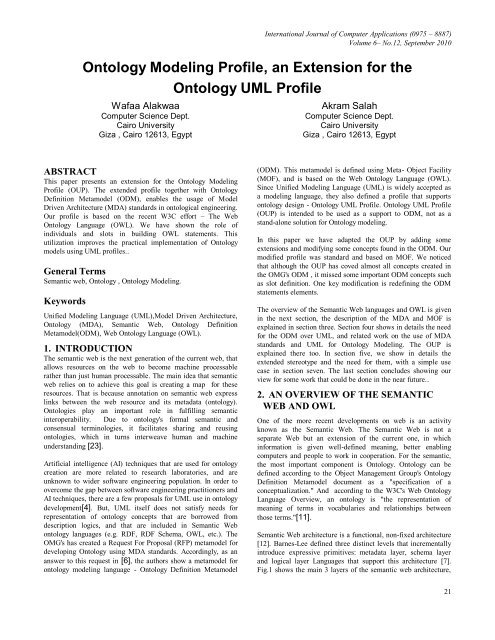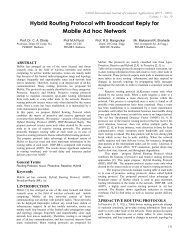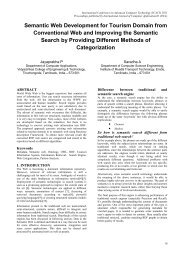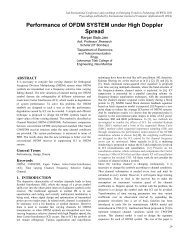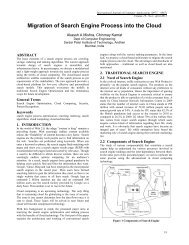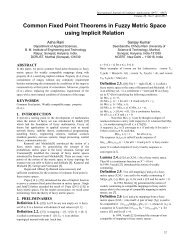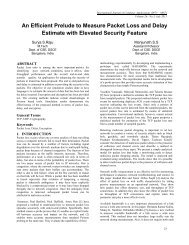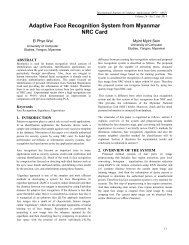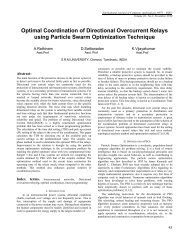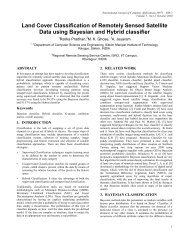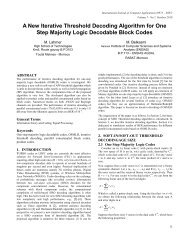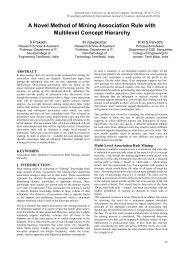Ontology Modeling Profile, an Extension for the ... - ResearchGate
Ontology Modeling Profile, an Extension for the ... - ResearchGate
Ontology Modeling Profile, an Extension for the ... - ResearchGate
Create successful ePaper yourself
Turn your PDF publications into a flip-book with our unique Google optimized e-Paper software.
International Journal of Computer Applications (0975 – 8887)<br />
Volume 6– No.12, September 2010<br />
<strong>Ontology</strong> <strong>Modeling</strong> <strong>Profile</strong>, <strong>an</strong> <strong>Extension</strong> <strong>for</strong> <strong>the</strong><br />
<strong>Ontology</strong> UML <strong>Profile</strong><br />
Wafaa Alakwaa<br />
Computer Science Dept.<br />
Cairo University<br />
Giza , Cairo 12613, Egypt<br />
Akram Salah<br />
Computer Science Dept.<br />
Cairo University<br />
Giza , Cairo 12613, Egypt<br />
ABSTRACT<br />
This paper presents <strong>an</strong> extension <strong>for</strong> <strong>the</strong> <strong>Ontology</strong> <strong>Modeling</strong><br />
<strong>Profile</strong> (OUP). The extended profile toge<strong>the</strong>r with <strong>Ontology</strong><br />
Definition Metamodel (ODM), enables <strong>the</strong> usage of Model<br />
Driven Architecture (MDA) st<strong>an</strong>dards in ontological engineering.<br />
Our profile is based on <strong>the</strong> recent W3C ef<strong>for</strong>t – The Web<br />
<strong>Ontology</strong> L<strong>an</strong>guage (OWL). We have shown <strong>the</strong> role of<br />
individuals <strong>an</strong>d slots in building OWL statements. This<br />
utilization improves <strong>the</strong> practical implementation of <strong>Ontology</strong><br />
models using UML profiles..<br />
General Terms<br />
Sem<strong>an</strong>tic web, <strong>Ontology</strong> , <strong>Ontology</strong> <strong>Modeling</strong>.<br />
Keywords<br />
Unified <strong>Modeling</strong> L<strong>an</strong>guage (UML),Model Driven Architecture,<br />
<strong>Ontology</strong> (MDA), Sem<strong>an</strong>tic Web, <strong>Ontology</strong> Definition<br />
Metamodel(ODM), Web <strong>Ontology</strong> L<strong>an</strong>guage (OWL).<br />
1. INTRODUCTION<br />
The sem<strong>an</strong>tic web is <strong>the</strong> next generation of <strong>the</strong> current web, that<br />
allows resources on <strong>the</strong> web to become machine processable<br />
ra<strong>the</strong>r th<strong>an</strong> just hum<strong>an</strong> processable. The main idea that sem<strong>an</strong>tic<br />
web relies on to achieve this goal is creating a map <strong>for</strong> <strong>the</strong>se<br />
resources. That is because <strong>an</strong>notation on sem<strong>an</strong>tic web express<br />
links between <strong>the</strong> web resource <strong>an</strong>d its metadata (ontology).<br />
Ontologies play <strong>an</strong> import<strong>an</strong>t role in fulfilling sem<strong>an</strong>tic<br />
interoperability. Due to ontology's <strong>for</strong>mal sem<strong>an</strong>tic <strong>an</strong>d<br />
consensual terminologies, it facilitates sharing <strong>an</strong>d reusing<br />
ontologies, which in turns interweave hum<strong>an</strong> <strong>an</strong>d machine<br />
underst<strong>an</strong>ding [23].<br />
Artificial intelligence (AI) techniques that are used <strong>for</strong> ontology<br />
creation are more related to research laboratories, <strong>an</strong>d are<br />
unknown to wider software engineering population. In order to<br />
overcome <strong>the</strong> gap between software engineering practitioners <strong>an</strong>d<br />
AI techniques, <strong>the</strong>re are a few proposals <strong>for</strong> UML use in ontology<br />
development[4]. But, UML itself does not satisfy needs <strong>for</strong><br />
representation of ontology concepts that are borrowed from<br />
description logics, <strong>an</strong>d that are included in Sem<strong>an</strong>tic Web<br />
ontology l<strong>an</strong>guages (e.g. RDF, RDF Schema, OWL, etc.). The<br />
OMG's has created a Request For Proposal (RFP) metamodel <strong>for</strong><br />
developing <strong>Ontology</strong> using MDA st<strong>an</strong>dards. Accordingly, as <strong>an</strong><br />
<strong>an</strong>swer to this request in [6], <strong>the</strong> authors show a metamodel <strong>for</strong><br />
ontology modeling l<strong>an</strong>guage - <strong>Ontology</strong> Definition Metamodel<br />
(ODM). This metamodel is defined using Meta- Object Facility<br />
(MOF), <strong>an</strong>d is based on <strong>the</strong> Web <strong>Ontology</strong> L<strong>an</strong>guage (OWL).<br />
Since Unified <strong>Modeling</strong> L<strong>an</strong>guage (UML) is widely accepted as<br />
a modeling l<strong>an</strong>guage, <strong>the</strong>y also defined a profile that supports<br />
ontology design - <strong>Ontology</strong> UML <strong>Profile</strong>. <strong>Ontology</strong> UML <strong>Profile</strong><br />
(OUP) is intended to be used as a support to ODM, not as a<br />
st<strong>an</strong>d-alone solution <strong>for</strong> <strong>Ontology</strong> modeling.<br />
In this paper we have adapted <strong>the</strong> OUP by adding some<br />
extensions <strong>an</strong>d modifying some concepts found in <strong>the</strong> ODM. Our<br />
modified profile was st<strong>an</strong>dard <strong>an</strong>d based on MOF. We noticed<br />
that although <strong>the</strong> OUP has coved almost all concepts created in<br />
<strong>the</strong> OMG's ODM , it missed some import<strong>an</strong>t ODM concepts such<br />
as slot definition. One key modification is redefining <strong>the</strong> ODM<br />
statements elements.<br />
The overview of <strong>the</strong> Sem<strong>an</strong>tic Web l<strong>an</strong>guages <strong>an</strong>d OWL is given<br />
in <strong>the</strong> next section, <strong>the</strong> description of <strong>the</strong> MDA <strong>an</strong>d MOF is<br />
explained in section three. Section four shows in details <strong>the</strong> need<br />
<strong>for</strong> <strong>the</strong> ODM over UML, <strong>an</strong>d related work on <strong>the</strong> use of MDA<br />
st<strong>an</strong>dards <strong>an</strong>d UML <strong>for</strong> <strong>Ontology</strong> <strong>Modeling</strong>. The OUP is<br />
explained <strong>the</strong>re too. In section five, we show in details <strong>the</strong><br />
extended stereotype <strong>an</strong>d <strong>the</strong> need <strong>for</strong> <strong>the</strong>m, with a simple use<br />
case in section seven. The last section concludes showing our<br />
view <strong>for</strong> some work that could be done in <strong>the</strong> near future..<br />
2. AN OVERVIEW OF THE SEMANTIC<br />
WEB AND OWL<br />
One of <strong>the</strong> more recent developments on web is <strong>an</strong> activity<br />
known as <strong>the</strong> Sem<strong>an</strong>tic Web. The Sem<strong>an</strong>tic Web is not a<br />
separate Web but <strong>an</strong> extension of <strong>the</strong> current one, in which<br />
in<strong>for</strong>mation is given well-defined me<strong>an</strong>ing, better enabling<br />
computers <strong>an</strong>d people to work in cooperation. For <strong>the</strong> sem<strong>an</strong>tic,<br />
<strong>the</strong> most import<strong>an</strong>t component is <strong>Ontology</strong>. <strong>Ontology</strong> c<strong>an</strong> be<br />
defined according to <strong>the</strong> Object M<strong>an</strong>agement Group's <strong>Ontology</strong><br />
Definition Metamodel document as a "specification of a<br />
conceptualization." And according to <strong>the</strong> W3C's Web <strong>Ontology</strong><br />
L<strong>an</strong>guage Overview, <strong>an</strong> ontology is "<strong>the</strong> representation of<br />
me<strong>an</strong>ing of terms in vocabularies <strong>an</strong>d relationships between<br />
those terms."[11].<br />
Sem<strong>an</strong>tic Web architecture is a functional, non-fixed architecture<br />
[12]. Barnes-Lee defined three distinct levels that incrementally<br />
introduce expressive primitives: metadata layer, schema layer<br />
<strong>an</strong>d logical layer L<strong>an</strong>guages that support this architecture [7].<br />
Fig.1 shows <strong>the</strong> main 3 layers of <strong>the</strong> sem<strong>an</strong>tic web architecture,<br />
21
International Journal of Computer Applications (0975 – 8887)<br />
Volume 6– No.12, September 2010<br />
where each of <strong>the</strong>se layers is based on a technology that plays a<br />
distinct role in deploying <strong>an</strong>d reusing learning objects on <strong>the</strong><br />
Sem<strong>an</strong>tic Web. Metadata layer based on XML <strong>an</strong>d RDF, schema<br />
layer based on RDF schema <strong>an</strong>d finally <strong>the</strong> logical layer that is<br />
based on OWL [5]<br />
L<strong>an</strong>guage), MOF (Meta-Object Facility), XMI (XML Metadata<br />
Interch<strong>an</strong>ge), <strong>an</strong>d CWM (Common Warehouse Metamodel).<br />
MDA also includes guidelines <strong>an</strong>d evolving supporting st<strong>an</strong>dards<br />
on model tr<strong>an</strong>s<strong>for</strong>mation <strong>an</strong>d pervasive services. The st<strong>an</strong>dards in<br />
MDA collectively define how a system c<strong>an</strong> be developed<br />
following a model driven approach <strong>an</strong>d using MDA compatible<br />
tools. Each MDA st<strong>an</strong>dard has its unique role in <strong>the</strong> overall<br />
MDA picture [16].<br />
MDA is based on <strong>the</strong> four-layer metamodeling architecture, as<br />
shown in Fig.2, which are :meta-metamodel (M3) layer,<br />
metamodel (M2) layer, model (M1) layer <strong>an</strong>d inst<strong>an</strong>ce (M0)layer<br />
[6] .<br />
Figure 1: OWL in <strong>the</strong> Sem<strong>an</strong>tic Web architecture.<br />
XML is used to markup <strong>the</strong> structure (syntax) of a resource in a<br />
machine readable way by associating metadata with resources.<br />
RDF allows <strong>the</strong> specification of metadata in a more flexible<br />
m<strong>an</strong>ner, facilitating <strong>the</strong> discovery <strong>an</strong>d exch<strong>an</strong>ge of resources with<br />
limited in<strong>for</strong>mation or more th<strong>an</strong> one metadata specifications.<br />
OWL allows <strong>the</strong> specification of concepts in a domain as well as<br />
<strong>the</strong> terms used to markup content [25].<br />
The OWL l<strong>an</strong>guage provides three increasingly expressive<br />
subl<strong>an</strong>guages designed <strong>for</strong> use by specific communities of<br />
implementers <strong>an</strong>d users. The OWL Lite supports <strong>the</strong> primarily<br />
classification hierarchy <strong>an</strong>d simple constraint features. OWL DL<br />
supports <strong>the</strong> maximum expressiveness without losing<br />
computational completeness <strong>an</strong>d decidability of reasoning<br />
systems. OWL Full is me<strong>an</strong>t <strong>for</strong> maximum expressiveness <strong>an</strong>d<br />
<strong>the</strong> syntactic freedom of RDF with no computational guar<strong>an</strong>tees<br />
[17]<br />
3. AN OVERVIEW OF MDA AND MOF<br />
Model driven development ( MDD ) constructs systems by me<strong>an</strong>s<br />
of models, which make systems seen from <strong>an</strong> abstract view.<br />
M<strong>an</strong>y models are created <strong>for</strong> <strong>the</strong> same system , each addresses<br />
different view [22] They (models) solve problems away from <strong>the</strong><br />
technical details, making world more reusable <strong>an</strong>d easy to create<br />
by domain experts, requiring less knowledge of specific<br />
computer systems [1].<br />
The Object M<strong>an</strong>agement Group (OMG), defined a framework<br />
called Model Driven Architecture (MDA) <strong>for</strong> model driven<br />
development. This framework (MDA) separates <strong>the</strong> system<br />
functionalities from <strong>the</strong> implementation details [15]. In MDA<br />
three types of viewpoints on models are distinguished. The<br />
computationally independent (CI) viewpoint sees <strong>the</strong> system<br />
from <strong>the</strong> customer's point of view, <strong>an</strong>d m<strong>an</strong>ifests it in a<br />
computation-independent model (CIM). This model is a typical<br />
<strong>an</strong>alysis model, since it is expressed in terms of <strong>the</strong> problem<br />
domain. The plat<strong>for</strong>m-independent (PI) viewpoint sees <strong>the</strong><br />
system from <strong>the</strong> designer's point of view, abstracts from all<br />
plat<strong>for</strong>ms a system may run on, <strong>an</strong>d results in a plat<strong>for</strong>m<br />
independent model (PIM). Finally, <strong>the</strong> plat<strong>for</strong>m-specific<br />
viewpoint adds plat<strong>for</strong>m specific extensions <strong>an</strong>d results in a<br />
plat<strong>for</strong>m-specific model (PSM). MDA is supported by a series of<br />
OMG st<strong>an</strong>dards, including <strong>the</strong> UML(Unified <strong>Modeling</strong><br />
Figure 2: MDA four-layer MOF-based metadata<br />
architecture.<br />
Meta-Object Facility (MOF), <strong>the</strong> M3 layer, is <strong>the</strong> responsible <strong>for</strong><br />
defining abstract l<strong>an</strong>guages <strong>an</strong>d frameworks <strong>for</strong> specifying,<br />
constructing <strong>an</strong>d m<strong>an</strong>aging technology neutral metamodels. It is<br />
<strong>the</strong> foundation <strong>for</strong> defining <strong>an</strong>y modeling l<strong>an</strong>guage; such as<br />
UML, a graphical modeling l<strong>an</strong>guage <strong>for</strong> specifying, visualizing<br />
<strong>an</strong>d documenting software systems. The models of <strong>the</strong> real<br />
world, represented by concepts defined in <strong>the</strong> corresponding<br />
metamodel at M2 layer (e.g. UML metamodel) are at M1 layer.<br />
Finally, at M0 layer are inst<strong>an</strong>ces of concepts modeled at M1<br />
layer [6].<br />
<strong>Extension</strong>s of <strong>the</strong> UML c<strong>an</strong> be ei<strong>the</strong>r heavyweight or lightweight.<br />
The difference between lightweight <strong>an</strong>d heavyweight extensions<br />
comes from <strong>the</strong> way in which <strong>the</strong>y extend <strong>the</strong> UML metamodel.<br />
Heavyweight extensions are based on a modified UML<br />
metamodel with <strong>the</strong> implication that <strong>the</strong> original sem<strong>an</strong>tics of<br />
modeling elements is ch<strong>an</strong>ged <strong>an</strong>d <strong>the</strong>re<strong>for</strong>e <strong>the</strong> extension might<br />
no longer be compatible with UML tools. Lightweight extensions<br />
are called UML profiles <strong>an</strong>d are based on <strong>the</strong> extension<br />
mech<strong>an</strong>isms provided by UML(stereotypes, tag definitions, <strong>an</strong>d<br />
constraints) <strong>for</strong> specializing its metaclasses, but without breaking<br />
<strong>the</strong>ir original sem<strong>an</strong>tics. UML profiles may impose new<br />
restrictions on <strong>the</strong> extended metaclasses, but <strong>the</strong>y should respect<br />
<strong>the</strong> UML metamodel, without modifying <strong>the</strong> original sem<strong>an</strong>tics<br />
of <strong>the</strong> UML elements (i.e., <strong>the</strong> basic features of UML classes,<br />
associations, properties, etc., will remain <strong>the</strong> same, only new<br />
constraints c<strong>an</strong> be added to <strong>the</strong> original elements). One of <strong>the</strong><br />
22
International Journal of Computer Applications (0975 – 8887)<br />
Volume 6– No.12, September 2010<br />
major benefits of profiles is that <strong>the</strong>y c<strong>an</strong> be h<strong>an</strong>dled in a natural<br />
way by UML tools [18].<br />
4. USING UML AND MDA-BASED<br />
STANDARDS IN ONTOLOGICAL<br />
ENGINEERING<br />
The import<strong>an</strong>ce <strong>an</strong>d use of ontology was exp<strong>an</strong>ded from being a<br />
basic building block of <strong>the</strong> Sem<strong>an</strong>tic web [14], to participate in<br />
m<strong>an</strong>y software applications <strong>an</strong>d <strong>the</strong> critical sem<strong>an</strong>tic foundation<br />
<strong>for</strong> m<strong>an</strong>y rapidly exp<strong>an</strong>ding technologies such as software agents,<br />
e-commerce <strong>an</strong>d knowledge m<strong>an</strong>agement [10]. This import<strong>an</strong>ce<br />
caused <strong>for</strong> m<strong>an</strong>y new tools to be developed to accelerate <strong>an</strong>d aid<br />
in building , representation, design <strong>an</strong>d construction of domain<br />
ontologies [20]. Most of <strong>the</strong> current Sem<strong>an</strong>tic Web ontologies<br />
are developed in AI laboratories. Because of this, <strong>the</strong> use of<br />
ontologies by Software engineers professionals <strong>an</strong>d researchers<br />
c<strong>an</strong> be seen as <strong>an</strong> additional learning experience, <strong>an</strong>d in some<br />
cases, of considerably great ef<strong>for</strong>t. Ano<strong>the</strong>r aspect is visualization<br />
<strong>for</strong> complex ontologies that need to be represented in a way that<br />
uses <strong>for</strong>mal notation with known tools.<br />
class), which by <strong>the</strong>mselves belong to special concept (class). A<br />
list of ontology classes exist each <strong>for</strong> different purpose. From<br />
describing a naturally occurring concepts(OWL:Class) to list of<br />
existing individual(enumeration) to concepts that is deduced<br />
from o<strong>the</strong>r concepts ei<strong>the</strong>r by union, intersection or complement.<br />
OWLRestriction class is responsible <strong>for</strong> setting values restriction<br />
or cardinality restrictions if exists. Individuals which are<br />
different from UML objects (inst<strong>an</strong>ces) are members of a<br />
classes. Ano<strong>the</strong>r <strong>an</strong>d import<strong>an</strong>t difference between Individual<br />
<strong>an</strong>d Object is that, individuals may be specified independently<br />
<strong>an</strong>d might not have <strong>the</strong> same set of properties that <strong>the</strong> class has,<br />
such as (sameAs, DifferentFrom) [17].<br />
The third shared concepts between UML <strong>an</strong>d ODM, but has<br />
completely different representation is property. Properties in<br />
UML , which are ei<strong>the</strong>r attributes or association's ends. As seen<br />
in Figure 3 properties appears ei<strong>the</strong>r in <strong>the</strong> class as <strong>an</strong> attribute,<br />
or in <strong>the</strong> association as <strong>an</strong> association end. So Property c<strong>an</strong> never<br />
be by itself in a model. It should be owned by some kind of class<br />
or association [2].<br />
Researchers have investigated that a strong coupling exists<br />
between <strong>the</strong> knowledge engineering <strong>an</strong>d software engineering<br />
phases of a knowledge-based system. These researches tried to<br />
converge between MDA st<strong>an</strong>dards <strong>an</strong>d ontology developments.<br />
Applying MDA techniques in developing ontologies has been<br />
discussed, focusing on what is common among <strong>the</strong>m [24].<br />
OMG ,as a consortium which develops st<strong>an</strong>dards <strong>for</strong> various<br />
aspects of software engineering which are widely used in<br />
industry, including UML, has published a RFP (Request <strong>for</strong><br />
Proposal) that tries to define a suitable l<strong>an</strong>guage <strong>for</strong> modeling<br />
Sem<strong>an</strong>tic Web ontology l<strong>an</strong>guages in <strong>the</strong> context of MDA. This<br />
RFP was responsible <strong>for</strong> modeling Web <strong>Ontology</strong> L<strong>an</strong>guage,<br />
which is a W3C ef<strong>for</strong>t. This metamodel will make ontology being<br />
used in a computing application. <strong>Ontology</strong> <strong>the</strong>n could be<br />
represented as some sort of computer-readable data structure [3].<br />
Although <strong>an</strong> ontology is a kind of data model, <strong>the</strong> UML<br />
metamodel, which is a rich in <strong>the</strong> purpose of representing data,<br />
widely used, <strong>an</strong>d well supported with software tools, was not<br />
being suitable <strong>for</strong> developing ontologies. The Web <strong>Ontology</strong><br />
l<strong>an</strong>guage has m<strong>an</strong>y shared concepts with <strong>the</strong> UML metamodel.<br />
But <strong>the</strong>se concepts have m<strong>an</strong>y deep differences, that make each<br />
has unique representation m<strong>an</strong>ner.<br />
The most import<strong>an</strong>t element is Class . A class in UML is a kind<br />
of classifier whose features are attributes <strong>an</strong>d operations. In<br />
UML, inst<strong>an</strong>ces (Objects) usually have more me<strong>an</strong>ing th<strong>an</strong> do<br />
classifiers because classifiers represent at least <strong>the</strong> first level of<br />
abstraction. Inst<strong>an</strong>ces under <strong>the</strong> same classifier help people<br />
underst<strong>an</strong>d what classifiers are. But class is not a collection of<br />
inst<strong>an</strong>ces (group of objects sharing <strong>the</strong> same description). Saying<br />
that "a class is a set of objects" is simply incorrect. Class is just a<br />
mold defining all <strong>the</strong> properties of inst<strong>an</strong>ces [2].<br />
While in ODM ,<strong>the</strong> concept Class refers to <strong>an</strong>y concept that<br />
could be modeled as a resource. The concept could be<br />
inst<strong>an</strong>tiated to create <strong>an</strong> individual or specified by having<br />
properties. A Class is a set of individuals (in contrast to UML<br />
Figure 3: Class <strong>an</strong>d Property concepts of <strong>the</strong> Kernel package.<br />
Unlike properties in ODM, properties are independent, st<strong>an</strong>d<br />
alone concepts. There exits two types of properties,<br />
DatatypeProperty <strong>an</strong>d ObjectProperty. The difference between<br />
<strong>the</strong>m is in <strong>the</strong> type of <strong>the</strong> r<strong>an</strong>ge <strong>the</strong>y link individual with.<br />
DatatypeProperties link individuals with primitive types value<br />
(e.g Integer, Boole<strong>an</strong>, String …), while ObjectProperties link<br />
individuals with individuals (e.g colleagueOf , hasParent..).<br />
Generally one c<strong>an</strong> map datatypeproerty to UML attribute while<br />
objectProperty could serve as UML association [13].<br />
In order <strong>for</strong> ODM to support well-known Sem<strong>an</strong>tic Web ontology<br />
l<strong>an</strong>guages, it has two separated metamodels, namely OWL <strong>an</strong>d<br />
RDFS Metamodels. These l<strong>an</strong>guages are W3C st<strong>an</strong>dards which<br />
<strong>for</strong>m a basis <strong>for</strong> <strong>the</strong> Sem<strong>an</strong>tic Web, thus are <strong>the</strong> central part of<br />
<strong>the</strong> ODM. O<strong>the</strong>r metamodels have two-way mappings to <strong>an</strong>d<br />
from RDFS/OWL. The o<strong>the</strong>r metamodels are Common L<strong>an</strong>guage<br />
(CL) metamodel, Topic Maps (TM) metamodel, <strong>an</strong>d <strong>the</strong><br />
Description Logics (DL) metamodel [3].<br />
23
International Journal of Computer Applications (0975 – 8887)<br />
Volume 6– No.12, September 2010<br />
Below we will have <strong>an</strong> overview of <strong>the</strong> main ODM concepts .<br />
4.1 The OMG's <strong>Ontology</strong> Definition<br />
Metamodel<br />
The Web <strong>Ontology</strong> L<strong>an</strong>guage is built on <strong>the</strong> top of RDF(S), using<br />
RDF(S) as both a meta-metamodel (M3) <strong>an</strong>d a metamodel that is<br />
a base <strong>for</strong> extension (M2). In <strong>the</strong> MOF MS, <strong>the</strong> first dependency<br />
(<strong>the</strong> use of RDFS as a metametamodel) is replaced by using <strong>the</strong><br />
MOF as a meta-metamodel. The second dependency me<strong>an</strong>s that<br />
<strong>the</strong> concepts of <strong>the</strong> OWL metamodel extend <strong>the</strong> concepts of <strong>the</strong><br />
RDFS metamodel. Most OWL concepts inherit <strong>the</strong> RDFS<br />
concepts RDFSResource, RDFProperty <strong>an</strong>d RDFClass.<br />
RDFSClass is a base concept of <strong>the</strong> OWL concepts that<br />
represents classes(OWLClass, OWLRestriction ), RDFProperty<br />
is inherited by m<strong>an</strong>y concepts that represent properties in OWL<br />
(OWLObjectProperty, OWLDatatypeProperty <strong>an</strong>d so on).<br />
OWLClass which is a set of individuals, inherits RDFSClass.<br />
OWLClass c<strong>an</strong> be defined in OWL in several o<strong>the</strong>r ways.<br />
Enumeration is defined by exhaustively enumerating its<br />
inst<strong>an</strong>ces. A class c<strong>an</strong> be constructed in OWL as a complement<br />
of <strong>an</strong>o<strong>the</strong>r class or as a union or intersection of o<strong>the</strong>r classes.<br />
OWLRestriction is a special kind of OWLClass, <strong>an</strong>d thus it<br />
inherits <strong>the</strong> OWLClass concept. It is not a “real” class, but a<br />
concept that enables constraints in OWL. OWL refines <strong>the</strong><br />
concept of rdf:Property by distinguishing two basic kinds of<br />
properties, owl:ObjectProperty <strong>an</strong>d owl:DatatypeProperty.<br />
Properties in OWL c<strong>an</strong>not have a Datatype as a domain, but only<br />
as a r<strong>an</strong>ge. A data r<strong>an</strong>ge represents a r<strong>an</strong>ge of data values. It c<strong>an</strong><br />
be ei<strong>the</strong>r a datatype or a set of data values. Data r<strong>an</strong>ges are used<br />
to specify a r<strong>an</strong>ge of datatype properties. They are modeled as <strong>the</strong><br />
OWLDataR<strong>an</strong>ge MOF Class [8].<br />
4.2 Related Work<br />
Several different approaches were proposed <strong>for</strong> ontology<br />
representation in UML. The main major trends among <strong>the</strong>m:<br />
Extending UML with new constructs to support specific<br />
concepts of ontologies (Property <strong>for</strong> example) [13].<br />
Using st<strong>an</strong>dard UML <strong>an</strong>d defining a UML profile <strong>for</strong><br />
ontology representation. This approach is mostly applied in<br />
<strong>the</strong> recent proposed solutions.<br />
M<strong>an</strong>y approaches suggested using UML <strong>for</strong> <strong>Ontology</strong><br />
Development. In 1999,Stephen et al. [21] , investigated <strong>the</strong> use<br />
of UML <strong>an</strong>d OCL <strong>for</strong> <strong>the</strong> representation of in<strong>for</strong>mation system<br />
ontologies. They examined <strong>the</strong> potential <strong>for</strong> object-oriented<br />
st<strong>an</strong>dards to be used <strong>for</strong> ontology modeling, <strong>an</strong>d in particular<br />
presents <strong>an</strong> ontology representation l<strong>an</strong>guage based on a subset<br />
of <strong>the</strong> Unified <strong>Modeling</strong> L<strong>an</strong>guage toge<strong>the</strong>r with its associated<br />
Object Constraint L<strong>an</strong>guage.<br />
In [13] <strong>the</strong> authors proposed to predefine several stereotypes so<br />
that a more detailed mapping from UML to <strong>the</strong> primitives offered<br />
by <strong>the</strong> DAML+OIL description logic c<strong>an</strong> be achieved. In [13], <strong>the</strong><br />
authors argued that <strong>the</strong> UML metamodel should be extended<br />
with elements such as property <strong>an</strong>d restriction so that UML<br />
becomes more compatible with KR l<strong>an</strong>guages like OWL. We<br />
believe that ontology representation in UML c<strong>an</strong> be achieved<br />
without nonst<strong>an</strong>dard UML extensions. Models created with<br />
UML profiles are supported by st<strong>an</strong>dard UML tools, since <strong>the</strong>y<br />
do not add nonst<strong>an</strong>dard concepts to UML, <strong>an</strong>d thus <strong>the</strong>y are<br />
UML models.<br />
Recently, Brockm<strong>an</strong>s et al. in [19], introduced a visual, UMLbased<br />
notation <strong>for</strong> OWL ontologies. They provide a st<strong>an</strong>dard<br />
MOF2 compli<strong>an</strong>t metamodel which captures <strong>the</strong> l<strong>an</strong>guage<br />
primitives offered by OWL DL. They also created a UML profile,<br />
which allows to visually model OWL ontologies in a notation<br />
that is close to <strong>the</strong> UML notation. This allows to develop<br />
ontologies using UML tools. The main drawback that we noticed<br />
in this work was on how to represent ObjectProperties <strong>an</strong>d<br />
datatyproperties. Object properties are represented as UML n-ary<br />
associations, while datatype properties are represented as UML<br />
attributes. This is not com<strong>for</strong>t to OWL, which uses <strong>the</strong> term<br />
property(ei<strong>the</strong>r object or Datatype) as <strong>an</strong> independent concept<br />
that is related to individuals via domain or r<strong>an</strong>ge links. The<br />
o<strong>the</strong>r drawback was that <strong>the</strong>y completely neglect <strong>the</strong> Statement<br />
concepts.<br />
In [7], D. Djuri et al. proposed a profile named "<strong>Ontology</strong> UML<br />
<strong>Profile</strong> (OUP)"; which, toge<strong>the</strong>r with <strong>Ontology</strong> Definition<br />
Metamodel (ODM), enables <strong>the</strong> usage of Model Driven<br />
Architecture (MDA) st<strong>an</strong>dards in ontological engineering. What<br />
make <strong>the</strong> OUP <strong>the</strong> best is <strong>the</strong>ir intend to represent OWL ontology<br />
, <strong>the</strong> recent W3C ef<strong>for</strong>t. O<strong>the</strong>r similar UML profiles are based on<br />
ontology representation l<strong>an</strong>guages, such as RDF(S), DAML+OIL,<br />
etc. Below is a brief description of this approach.<br />
4.2.1 The <strong>Ontology</strong> UML <strong>Profile</strong> (OUP)<br />
In <strong>an</strong>swer to <strong>the</strong> OMG RFP <strong>an</strong> architecture was created in [6],<br />
that proposes several specifications to be defined, as shown in<br />
Figure 4 :<br />
Figure 4: <strong>Ontology</strong> modeling in <strong>the</strong> context of MDA <strong>an</strong>d<br />
Sem<strong>an</strong>tic Web.<br />
<strong>Ontology</strong> Definition Metamodel (ODM)<br />
<strong>Ontology</strong> UML <strong>Profile</strong> - a UML <strong>Profile</strong> that supports UML<br />
notation <strong>for</strong> ontology definition.<br />
24
International Journal of Computer Applications (0975 – 8887)<br />
Volume 6– No.12, September 2010<br />
Two-way mappings between OWL <strong>an</strong>d ODM, ODM <strong>an</strong>d<br />
<strong>Ontology</strong> UML <strong>Profile</strong> <strong>an</strong>d from <strong>Ontology</strong> UML <strong>Profile</strong><br />
to o<strong>the</strong>r UML profiles<br />
The OUP developer firstly defined <strong>the</strong> place of ODM <strong>an</strong>d OUP<br />
in <strong>the</strong> context of <strong>the</strong> MDA four layer architecture <strong>an</strong>d identify <strong>the</strong><br />
main OWL concepts. Then, to support ODM, <strong>the</strong>y defined <strong>the</strong><br />
OUP <strong>an</strong>d describe its details. The proposed UML profile enables<br />
usage of <strong>the</strong> well-known UML notation in ontological<br />
engineering more extensively. The purpose of OUP is to enable<br />
<strong>the</strong> use of <strong>the</strong> st<strong>an</strong>dard UML graphical notation <strong>for</strong> developing<br />
ontologies. You c<strong>an</strong> refer to [7] <strong>for</strong> more in<strong>for</strong>mation.<br />
Due to <strong>the</strong> difference between UML <strong>an</strong>d ontology class, as it is<br />
defined in OWL (owl:Class), OUP defined a stereotyped<br />
\textit{} UML classes to model ontology classes.<br />
And m<strong>an</strong>y subclasses of <strong>the</strong> class OWL:Class , stereotyped<br />
, , ,<br />
, <strong>an</strong>d <strong>for</strong><br />
classes namely Enumeration, Union, Intersection, Complement,<br />
Restriction <strong>an</strong>d AllDifferent respectively. Also, <strong>the</strong>re are m<strong>an</strong>y<br />
differences between UML objects <strong>an</strong>d OWL:Individual, OUP has<br />
stereotyped UML objects as .<br />
Property in OWL is a st<strong>an</strong>dalone concept, different from <strong>the</strong><br />
property concept used in UML. Because of that, OUP used <strong>the</strong><br />
st<strong>an</strong>d alone concept in UML, class, stereotyped by<br />
<strong>for</strong> properties among individuals <strong>an</strong>d<br />
<strong>for</strong> properties among individuals <strong>an</strong>d<br />
primitive data type.<br />
OWL statements are represented via concrete links between<br />
ontology inst<strong>an</strong>ces, individuals. In OUP, Statement is<br />
represented as <strong>an</strong> Object , "ObjectProperty" or<br />
"DatatypeProperty", with two Links - <strong>the</strong> subject Link <strong>an</strong>d <strong>the</strong><br />
object Link. Unlike o<strong>the</strong>r MDA-based approaches to ontology<br />
development both ODM <strong>an</strong>d OUP support modeling of body of<br />
knowledge (i.e. class inst<strong>an</strong>ces) [9].<br />
We have chosen this profile <strong>an</strong>d <strong>the</strong>n updated it because of m<strong>an</strong>y<br />
reasons:<br />
OUP is specialized <strong>for</strong> modeling <strong>the</strong> recent W3C ef<strong>for</strong>t<br />
(OWL).<br />
It has coved almost all <strong>the</strong> practical part of building<br />
ontology,(e.g: Statements).<br />
It shows in details how to use UML modeling tools in<br />
developing <strong>Ontology</strong> using <strong>the</strong>ir profile. For more<br />
details you c<strong>an</strong> refer to [8].<br />
5. THE PROPOSED ONTOLOGY<br />
MODELING PROFILE (OMP)<br />
From <strong>the</strong> above expl<strong>an</strong>ation of <strong>the</strong> OUP, we have noticed that <strong>the</strong><br />
OUP was a complete <strong>an</strong>d worth work not to be neglected. The<br />
ef<strong>for</strong>t spent <strong>the</strong>ir could be accomp<strong>an</strong>ied with our extra <strong>an</strong>d<br />
modified stereotypes to generate a valid <strong>an</strong>d practice oriented<br />
profile.<br />
5.1 OWLDataR<strong>an</strong>ge<br />
Through <strong>the</strong> <strong>an</strong>alysis of <strong>the</strong> ODM, Enumeration are represented<br />
in two m<strong>an</strong>ner. The class called enumeration, which is<br />
stereotyped in <strong>the</strong> OUP. Enumeration is a<br />
class where its elements are individuals. This is due to <strong>the</strong> fact<br />
that in <strong>Ontology</strong>, a class is a set of individuals. The second type<br />
of Enumeration mentioned in <strong>the</strong> ODM was, DataR<strong>an</strong>ge, in<br />
which elements are all primitive literals(e.g Integer, String,<br />
Boole<strong>an</strong> ,.)<br />
Figure 5: OWLDataR<strong>an</strong>ge in <strong>the</strong> OWL metamodel.<br />
5.2 OWLStatement<br />
Statement in OWL, is inherited from RDFStatement. From <strong>the</strong><br />
definition of RDFStatement, we c<strong>an</strong> see that all three<br />
associations, subject, object <strong>an</strong>d predicate, link RDFStatement to<br />
RDFSResource as shown in Figure 6. This design is wide open<br />
to <strong>an</strong>y kinds of statement, even one that does not me<strong>an</strong> <strong>an</strong>ything.<br />
There<strong>for</strong>e, <strong>the</strong> predicate should usually be a resource that<br />
represents a verb, such as "be" or "memorize", or some<br />
characteristic of a resource, like "name". In <strong>the</strong> RDFS MS, such a<br />
resource is <strong>an</strong> rdf:Property, a concept that represents a type of<br />
relationship between resources [17].<br />
Figure 6: OWLStatement in <strong>the</strong> OWL metamodel.<br />
From <strong>the</strong> above definition of a statement in <strong>the</strong> ODM<br />
metamodel, we think that statement in ODM is not supposed to<br />
have a similar concept in UML. What is being represented is its<br />
elements, Subject ,object <strong>an</strong>d Predicate. The OUP has preferred<br />
to use link, <strong>an</strong>d link ends. In our opinion , Subject, object <strong>an</strong>d<br />
predicate are not links, <strong>the</strong>y are individuals <strong>an</strong>d Object property<br />
inst<strong>an</strong>ces. A statement in OWL has to link 3 inst<strong>an</strong>ces, each<br />
plays a role in this statement. If subject is <strong>an</strong> Individual,<br />
predicate could be <strong>an</strong> inst<strong>an</strong>ce of <strong>an</strong> object property , <strong>an</strong>d <strong>the</strong><br />
object could be <strong>an</strong>o<strong>the</strong>r individual or <strong>the</strong> same subject individual<br />
in case of symmetric object properties. So <strong>the</strong> proposed OMP<br />
define stereotyped inst<strong>an</strong>ce specification named <br />
of a class stereotyped <strong>an</strong>d a stereotyped<br />
inst<strong>an</strong>ce specification named <strong>an</strong>d <strong>for</strong> a<br />
class or .<br />
25
International Journal of Computer Applications (0975 – 8887)<br />
Volume 6– No.12, September 2010<br />
Figure 7 shows <strong>the</strong> Inst<strong>an</strong>ceSpecification metaclass with all new<br />
defined stereotypes, <strong>the</strong> one with gray background was recently<br />
defined.<br />
of <strong>the</strong> museum ontology <strong>an</strong>d its properties. The museum is being<br />
shown in its class diagram in Figure 9.<br />
Figure 7: MetaClass Inst<strong>an</strong>ceSpecification extended concepts<br />
in <strong>the</strong> OMP.<br />
As a statement is a coherent inst<strong>an</strong>ces connected toge<strong>the</strong>r, we<br />
used links (inst<strong>an</strong>ceSpecification with classifier association) to<br />
connect those three elements.We defined two stereotype link,<br />
to connect subject <strong>an</strong>d predicate <strong>an</strong>d to<br />
connect predicate <strong>an</strong>d object.<br />
Slots are inst<strong>an</strong>ces of Properties, ei<strong>the</strong>r used in Class as<br />
attributes or in association as Association End. Slots in our<br />
profile plays <strong>an</strong> import<strong>an</strong>t role. Although <strong>the</strong> OUP has identified<br />
individuals, it did not shows how to create inst<strong>an</strong>ces of data type<br />
properties or object properties. According to ODM we defined<br />
three stereotyped slots, as shown in Figure 8. The first is<br />
which links individuals with<br />
datatypeproperties inst<strong>an</strong>ces value. The second <strong>an</strong>d <strong>the</strong> third<br />
types are <strong>an</strong>d which define <strong>the</strong><br />
subject <strong>an</strong>d object of a statement respectively.<br />
Figure 9: Part Of The Museum Class Diagram .<br />
6. CASE STUDY<br />
The case study below shows how OMP is applied on <strong>the</strong> museum<br />
class diagram. The UML classes we used in <strong>the</strong> use case are<br />
"museum ,painting, painter". Using <strong>the</strong> OUP, <strong>the</strong> owl:classes are<br />
painting, painter <strong>an</strong>d museum, each represent a concept in <strong>the</strong><br />
domain. Following <strong>the</strong> OUP method to define property we see<br />
that <strong>for</strong> example, class Museum is <strong>the</strong> domain of two Data type<br />
properties , MuseumCity <strong>an</strong>d MuseumName which are<br />
stereotyped , as shown in Figure 10.<br />
Figure 8: MetaClass Slot extended concepts in <strong>the</strong> OMP.<br />
Ano<strong>the</strong>r light addition is <strong>the</strong> adding of some tagged values to <strong>the</strong><br />
object Properties. The one who notices <strong>the</strong> mapping between<br />
OWL:ObjectProperty <strong>an</strong>d UML:Association, will know how<br />
import<strong>an</strong>ce to know if such relation is composition or<br />
aggregation. So we added two main boole<strong>an</strong> Tagged values to <strong>the</strong><br />
ObjectProperty Stereotype. ISAggregation <strong>an</strong>d IsComposition to<br />
define if <strong>the</strong> relation such as (has_a) is composed or aggregated.<br />
Figure 10: OWLCLasses from <strong>the</strong> Museum Class Diagram .<br />
To represent Data type properties, we stereotyped UML classes<br />
as >, as shown in Figure 11. The property<br />
stereotyped within <strong>the</strong> MuseumName, <strong>for</strong> example,<br />
link it with <strong>the</strong> r<strong>an</strong>ge, which is in this case , The primitive data<br />
type String.<br />
The next section describe a simple case study representing part<br />
26
International Journal of Computer Applications (0975 – 8887)<br />
Volume 6– No.12, September 2010<br />
Figure 13: Individual from <strong>the</strong> Museum Class Diagram.<br />
Figure 11:DatatypeProperties from <strong>the</strong> Museum Class<br />
Diagram .<br />
Unlike datatypeProperties, object properties are connected with<br />
<strong>the</strong>ir domains <strong>an</strong>d r<strong>an</strong>ges, using associations stereotyped<br />
<strong>an</strong>d respectively, as shown in Figure 12.<br />
Figure 12:ObjectProperties from <strong>the</strong> Museum Class<br />
Diagram.<br />
Individuals in OWL represent inst<strong>an</strong>ces of owl:classes. They are<br />
ei<strong>the</strong>r subject or object as shown in <strong>the</strong> Figure 13. Object<br />
properties inst<strong>an</strong>ces are predicates(if <strong>the</strong>y participate in a<br />
statement) that connect subject with object.<br />
Note that in our approach data type properties do not participate<br />
as a part in <strong>the</strong> OWL statement constructions. They are used to<br />
fill in <strong>the</strong> slots value of owl class. For example, <strong>the</strong> inst<strong>an</strong>ce of<br />
owl:class painting named Autoportrait has 2 data type slots, one<br />
is title which was given <strong>the</strong> value of <strong>an</strong> inst<strong>an</strong>ce of a data type<br />
Property class named AutoportraitTile , <strong>an</strong>d <strong>the</strong> second is year<br />
which was given a value of <strong>the</strong> inst<strong>an</strong>ce of data type property<br />
named year as shown in Figure 13.<br />
For more clarifying lets take <strong>the</strong> statement as <strong>an</strong> example. Using Individuals it will be interpreted<br />
as . For subject slot, <strong>the</strong><br />
navigable link stereotyped between <strong>the</strong> subject<br />
Pablo Picasso Painter has <strong>an</strong> association end property referring to<br />
<strong>the</strong> subject of <strong>the</strong> statement, which is Pablo Picasso. We<br />
stereotyped this owned end property with . The<br />
object slot is not owned by <strong>the</strong> link, ra<strong>the</strong>r, it was owned by <strong>the</strong><br />
predicate, in this case Paints. This slot that has <strong>the</strong> same type as<br />
<strong>the</strong> object , which is <strong>the</strong> painting Autoportrait is stereotyped<br />
.<br />
7. CONCLUSION<br />
The <strong>Ontology</strong> <strong>Modeling</strong> <strong>Profile</strong>, that was extended from <strong>the</strong><br />
OUP, toge<strong>the</strong>r with ODM are in accord<strong>an</strong>ce with <strong>the</strong> OMG’s<br />
RFP initiative <strong>for</strong> ontology modeling. We concern <strong>the</strong> individual<br />
modeling with statement constructing elements. This profile<br />
enables using ontologies in <strong>the</strong> way that is closer to software<br />
engineering practitioners. Also, since <strong>the</strong> UML <strong>an</strong>d ODM are<br />
defined as MOF-compli<strong>an</strong>t l<strong>an</strong>guages it is possible to store<br />
ontologies in MOF-based repositories, to store ontology diagrams<br />
in a st<strong>an</strong>dard way (UML2 XMI), as well as to share <strong>an</strong>d<br />
interch<strong>an</strong>ge ontologies using XMI. With <strong>the</strong> <strong>Ontology</strong> UML<br />
<strong>Profile</strong>, <strong>the</strong> ODM concepts c<strong>an</strong> be used as stereotypes in <strong>the</strong><br />
UML models.<br />
A practical implementation <strong>for</strong> mapping between <strong>Ontology</strong><br />
model <strong>an</strong>d Requirement model will be carried out using <strong>the</strong><br />
OMP to show how this profile was able to converge between<br />
MDA st<strong>an</strong>dards <strong>an</strong>d <strong>the</strong> Web <strong>Ontology</strong> L<strong>an</strong>guage. We pl<strong>an</strong> to<br />
extract <strong>the</strong> requirement <strong>an</strong>alysis model from <strong>the</strong> domain model<br />
(ontology), accordingly we aim to use model tr<strong>an</strong>s<strong>for</strong>mation from<br />
<strong>the</strong> <strong>Ontology</strong> Model (OM) to <strong>the</strong> Requirement Analysis Model<br />
(RAM). We also aim to make automatic generation of <strong>the</strong> Web<br />
<strong>Ontology</strong> L<strong>an</strong>guage (OWL) from UML model based on our<br />
profile (OMP).This conversion tr<strong>an</strong>s<strong>for</strong>ms <strong>an</strong> ontology from its<br />
OMP into OWL description. Accordingly, this generated OWL<br />
model c<strong>an</strong> be shared with ontological engineering tools (i.e.<br />
Protge).<br />
27
International Journal of Computer Applications (0975 – 8887)<br />
Volume 6– No.12, September 2010<br />
8. REFERENCES<br />
[1] S. Br<strong>an</strong>. The pragmatics of model-driven development.<br />
IEEE Software, vol. 20, no. 5, pp. 19-25, 2003.<br />
[2] M. D. BUI. Real-Time Object Uni<strong>for</strong>m Design Methodology<br />
with UML. Springer, 2007.<br />
[3] C. Coral, R Fr<strong>an</strong>cisco, <strong>an</strong>d P. Mario. Ontologies <strong>for</strong><br />
Software Engineering <strong>an</strong>d Software Technology. Springer-<br />
Verlag Berlin Heidelberg, Fr<strong>an</strong>cis, 2006.<br />
[4] S. Cr<strong>an</strong>efield. Uml <strong>an</strong>d <strong>the</strong> sem<strong>an</strong>tic web. In Proceedings<br />
of <strong>the</strong> International Sem<strong>an</strong>tic Web Working Symposium,<br />
Palo Alto, 2001.<br />
[5] D. Djuric, Gasevic D., Damj<strong>an</strong>ovic V., <strong>an</strong>d Devedzic V.<br />
MDA-Based Ontological Engineering, pages 203{231.<br />
World Scientific Publishing Co., Singapore, 2005.<br />
[6] D. Djuric, D.<strong>an</strong>d Gasevic <strong>an</strong>d V. Devedzic. <strong>Ontology</strong><br />
modeling <strong>an</strong>d mda. Journal of Object Technology, vol. 4, no.<br />
1, pp. 109-128, 2005.<br />
[7] D. Drag<strong>an</strong>, G. Drag<strong>an</strong>, D. Vlad<strong>an</strong>, <strong>an</strong>d D. Violeta. A uml<br />
profile <strong>for</strong> owl ontologies. In Proc. of <strong>the</strong> Workshop on<br />
Model Driven Architecture: Foundations <strong>an</strong>d Applications,<br />
pages 138-152, Linkoping University, Sweden, 2004.<br />
[8] D. Drag<strong>an</strong>, G.<strong>an</strong>d Drag<strong>an</strong> <strong>an</strong>d D. Vlad<strong>an</strong>. Model Driven<br />
Architecture <strong>an</strong>d <strong>Ontology</strong> Development. Springer-Verlag<br />
Berlin Heidelberg, 2006.<br />
[9] D. Gasevic, D. Djuric, <strong>an</strong>d Devedzic V. Bridging mda <strong>an</strong>d<br />
owl ontologies. Journal of Web Engineering, 4(1):119-135,<br />
2005.<br />
[10] H<strong>an</strong>s-Jo"rg Happel <strong>an</strong>d Stef<strong>an</strong> Seedorf. Applications of<br />
ontologies in software engineering In International<br />
Workshop on Sem<strong>an</strong>tic Web Enabled Software Engineering<br />
(SWESE'06), November 2006.<br />
[11] Thomas C. J. Just what is <strong>an</strong> ontology, <strong>an</strong>yway? IT<br />
Professional, 11:22-27, 2009.<br />
[12] Z. P. Je_ <strong>an</strong>d H. I<strong>an</strong>. Metamodeling architecture ofweb<br />
ontology l<strong>an</strong>guages. In Proc. of <strong>the</strong> Sem<strong>an</strong>tic Web Working<br />
Symposium, pages 131-149, July 2001.<br />
[13] K. K. Kenneth, B.<strong>an</strong>d Mieczyslaw, A. K Paul, H. Lewis, S.<br />
Jefferey, S. H. William, Jerzy Letkowski, <strong>an</strong>d L. Aronson<br />
Michael. Extending <strong>the</strong> unified modeling l<strong>an</strong>guage <strong>for</strong><br />
ontology development. Software <strong>an</strong>d System <strong>Modeling</strong><br />
(SoSyM), vo. 1, no. 2, pp. 142-156, 2002.<br />
[14] D. Li, K. Pr<strong>an</strong>am, D. Zhongli, A. Sasik<strong>an</strong>th, <strong>an</strong>d J. Anupam.<br />
Using ontologies in <strong>the</strong> sem<strong>an</strong>tic web: A survey. Technical<br />
report, UMBC, July 2005.<br />
[15] G. Matthias. What is mdd/mda <strong>an</strong>d where will it lead <strong>the</strong><br />
software development in <strong>the</strong> future? May 2007.<br />
[16] K. S. Michael, W. Chris, <strong>an</strong>d L. M. Deborah. Mda guide<br />
version 1.0.1. http://www.omg.org/cgi-bin/doc?omg/03-06-<br />
01.pdf, 12 June 2003.<br />
[17] K. S. Michael, W. Chris, <strong>an</strong>d L. M. Deborah. Owl web<br />
ontology l<strong>an</strong>guage guide. http://www.w3.org/TR/owl-guide/,<br />
10 Feb. 2004.<br />
[18] N. Moreno, J. R. Romero, <strong>an</strong>d A. Vallecillo. An overview of<br />
model-driven web engineering <strong>an</strong>d <strong>the</strong> mda. pages 353-382.<br />
2008.<br />
[19] B. Sara, V. Raphael, E. Andreas, <strong>an</strong>d L. Peter. Visual<br />
modeling of owl dl ontologies using uml. In The Sem<strong>an</strong>tic<br />
Web ISWC 2004, pages 198-213. Springer, 2004.<br />
[20] S. C. Seria, C. B. Sabin, C. Lili<strong>an</strong>a, <strong>an</strong>d C. N. Ovidiu.<br />
Survey on web ontology editing tools.<br />
http://thor.info.uaic.ro/~busaco/publications/articles/webontology-tool-survey.pdf,<br />
2006.<br />
[21] C. Stephen <strong>an</strong>d P. Martin. Uml as <strong>an</strong> ontology modelling<br />
l<strong>an</strong>guage. In Proceedings of <strong>the</strong> Workshop on Intelligent<br />
In<strong>for</strong>mation Integration, 16th International Joint Conference<br />
on Artificial Intelligence (IJCAI’99), pages 46-53, 1999.<br />
[22] J. M. Stephen, N. C. Anthony, <strong>an</strong>d F. Takao. Model-driven<br />
development. IEEE Software, pages 14-18, Sep./Oct. 2003.<br />
[23] F. v<strong>an</strong> Harmelen. The sem<strong>an</strong>tic web: what, why, how, <strong>an</strong>d<br />
when. IEEE Distributed Systems Online, vol. 5, no. 3, pp. 1-<br />
4, 2004.<br />
[24] X. W<strong>an</strong>g <strong>an</strong>d C.W. Ch<strong>an</strong>. <strong>Ontology</strong> modeling using uml. In<br />
Proc. of <strong>the</strong> Seventh International Conference on Object<br />
Oriented In<strong>for</strong>mation Systems (OOIS), pages 59 -70,<br />
Calgary, C<strong>an</strong>ada, Aug. 2001.<br />
[25] V. Siricharoen Waralak. <strong>Ontology</strong> modeling <strong>an</strong>d object<br />
modeling in software engineering. International Journal of<br />
Software Engineering <strong>an</strong>d Its Applications, vol. 3, no. 1, pp.<br />
43-60, 2009.<br />
28


